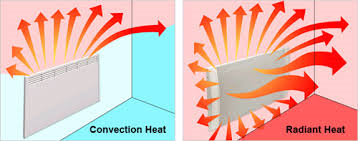The science of modern electric heating is based on the laws of thermodynamics
The law of thermodynamics say there are three ways heat can be transferred.
1) Conduction- Heat travelling from an area of high temperature to an area of low temperature within an object.
2) Convection – Heat circulation in an atmosphere of water or gas
3 )Radiation- Electromagnetic transfer even within a vacuum.

The majority of old heating systems rely on convection, examples being storage heaters (warm air coming out of the top), cheap portable heaters and fan heaters .
Radiant heat-the key to economic electric heating
Radiant heaters produce primarily radiant heat Traditional central heating radiators are designed accordingly, which why they are called radiators.
Radiators are designed to radiate heat into the room giving a fairly even distribution of heat. Convector heaters produce warm air, which firstly rises to the ceiling and then eventually works it way down to the lower part of the room. This gives a big temperature differential between the ceiling and the rest of the room , causing draughts and generally being inefficient and more expensive to run.
So radiant heat isn’t a new thing, but advances in the science of modern electric heating have enabled the production of radiant heaters that are both more efficient and more economical to run

Radiant heat is part of the electromagnetic spectrum. Heat from the sun is radiant heat. A typical example might be you standing outside on a cold cloudy day, suddenly there is a break in the cloud and the sun shines though. You immediately feel warmer. The air temperature hasn’t changed, but the radiant heat from the sun warms you up.
Another example might be skiers sunbathing on top of a mountain. The air temperature could be well below freezing. But the radiant heat from the sun means they are warm and can take off much of their cold weather gear.

What type of heat do we prefer? Well think about an open fireplace or a wood burning stove. All the hot air goes up the chimney. It is the radiant heat from the fire that keeps us warm and cosy.

So radiant heat is part of the electromagnetic spectrum, but it consists of a fairly broad range of wavelengths. By focusing on producing radiant heat at a specific wavelength, which our bodies react the most positively to, then we can get the maximum benefit in terms of feeling warm, with less use of energy. The part of the electromagnetic spectrum are bodies respond to particularly well to is called Far infrared. Research has shown the optimum frequency for Far Infrared heaters is in the range of 6 to 12 microns with a good portion of wavelengths at 9.4 microns, the optimal absorption range of far infrared by the human body.

Far Infrared heat
Far infrared heaters are designed to emit as near as possible to this wavelength, to give the maximum benefit. In fact it has been shown that people using Far Infrared to heat their home are often comfortable with an air temperature of two or three degrees centigrade less than they might be with more traditional heating.
So with many forms of radiant heaters , radiant heat is produced across a fairly broad range of electromagnetic frequencies. Far Infrared heaters are specifically designed to emit frequencies that the human body responds to best. This not only gives a cosy comfortable heat, but the energy usage (electricity costs) to heat a room of a given size and can be significantly reduced too.
When we think of radiant heat from the sun, it travels though space as electromagnetic radiation. When it hits an object the atoms in that object vibrate faster which causes it to warm up. That object then becomes whats known as a secondary emitter and also emits radiant heat.
This is what happens with a Far Infrared heater. It warms up objects in the room, walls furniture, people, which then become very low level secondary emitters. Over time, what is known as thermal mass builds up in the rooms walls, furniture etc which then warms the air and the room feels comfortable. not just from the warm air, but also from the effect of all the secondary emitters warming your body.
One expert in this field once told me to think of it as a room consisting of mirrors. You sign a torch in one direction and the light bounces all round the room.
As you can see on the above chart the visible spectrum is very similar to Far Infrared in many ways. In fact if you place a Far Infrared Heater on a wall facing a window, much of the energy will simply go through the window, as there is nothing for it to hit and be absorbed. Just like shining a torch through a window.
Every object emits infrared , sometimes it can be very little, even an ice cube emits infrared heat, a hot iron bar would emit more, people emit infrared. Infrared cameras are often used to find people in the dark by showing infrared heat rather than light.
Here are some pictures taken with an infrared camera

A seat where someone had recently been sitting You can clearly see the temperature difference 
Kitchen window from outside. You can see the effect of warm water in the outside drain pipe. and the heat loss through walls and windows 
This picture shows people emitting heat especially from their faces, compare it with the colder walls in the background 
Here you can clearly see the stud positions behind the wall and how some areas are not very well insulated. Compared to the colder parts of the wall the settee is warmer and radiating heat
This clearly shows the basis of the science of modern electric heating, how different objects emit and absorb different amounts of radiant heat. As with any heating situation, the key to to an efficient and cost effective heating scenario is, apart from energy efficient radiant heaters … insulation.
More info on types of economic electric heating
